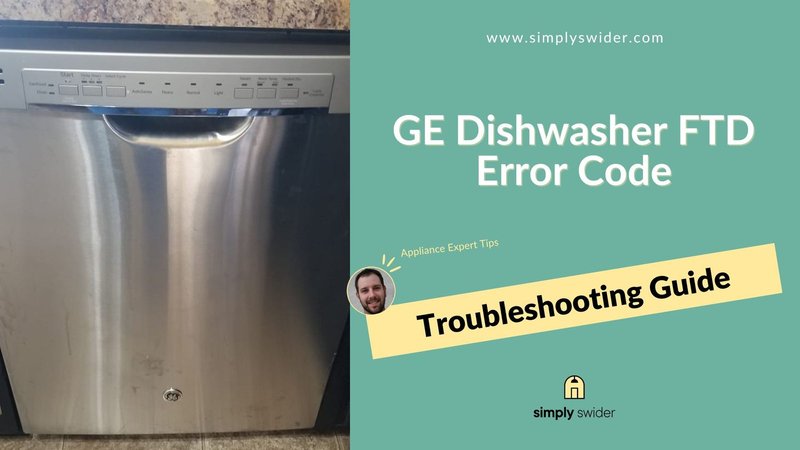
When a GE dishwasher displays an “OE” error, it’s often hinting at trouble with the drainage system. Imagine your dishwasher trying to empty water at the end of its cycle, but the water has nowhere to go due to a blockage or malfunction. This scenario can cause a domino effect of problems, such as poor cleaning performance and even potential damage to your dishwasher. But don’t worry! Understanding what’s going on and how to tackle it can save you from unnecessary hassle and expense.
Understanding the GE Dishwasher Error OE
The “OE” error code on your GE dishwasher is like a red flag waving to catch your attention. It’s telling you there’s a problem with the dishwasher’s drainage system, which is responsible for removing dirty water after each wash. Think of it as a traffic jam in your dishwasher’s highway, where water is the traffic and the highway is the drainage system. If water can’t exit properly, it’ll back up, causing the dishwasher to spit out the error code and possibly leaving your dishes feeling less than sparkling clean.
One of the most common causes of this error is a clogged or kinked drain hose. This hose is like the exit ramp for water, and if it’s blocked, everything comes to a standstill. You might also find that the drain pump, a crucial component that pushes the water out, could be faulty. Imagine trying to blow air through a pinched straw; that’s what your dishwasher faces with a faulty pump.
Without addressing the “OE” error, you might end up with water pooling at the bottom of the dishwasher, resulting in damp dishes and a less efficient appliance. If ignored, over time, continual standing water can lead to unpleasant odors or even mold growth, much like ignored leftovers in the back of your fridge.
Consequences of Ignoring the OE Error
Here’s the deal: ignoring the “OE” error can lead to a cascade of issues, both for your dishes and the dishwasher itself. You might be wondering, “What’s the worst that could happen?” Well, let’s explore a few potential consequences.
First, your dishes might not come out as clean as they should. A dishwasher with drainage issues can’t effectively remove all the dirty water, meaning detergent residues and food particles might remain on your plates and glasses. It’s a bit like expecting a rain shower to wash your car when it’s barely drizzling.
Moreover, persistent drainage problems can eventually wear out the dishwasher’s pump. This small but mighty component works hard to expel water—and overworking it can cause it to break down. Replacing a pump can be costly and time-consuming, much like replacing a flat tire that could’ve been avoided with regular maintenance.
Lastly, the ignored moisture can lead to more serious water damage to your kitchen floor and cabinets, which can lead to costly repairs. Think of it as leaving a snowball at the top of a hill; it can easily turn into an avalanche if left unchecked.
Steps to Resolve GE Dishwasher Error OE
Now, let’s get proactive. If your dishwasher is flashing the “OE” error, there are steps you can take to address it before calling in a professional. Imagine this process as your DIY toolkit for keeping your dishwasher in great shape.
First, check the drain hose for any visible kinks or clogs. You can do this by gently straightening any bends and ensuring it’s not blocked. If the hose is clogged, it will need cleaning. Think of it as giving your dishwasher a clear path to the exit, much like clearing a blocked driveway.
Next, inspect the dishwasher’s filter. If it’s filled with debris, it’s like trying to run a marathon with a cold. A clean filter ensures the water can flow freely through the system. Wash it with warm, soapy water for optimal performance.
Finally, if the error persists, it might be time to look at the drain pump. This component has a big job and might need replacing if it’s not functioning correctly. While this task might be better suited for a professional, understanding its function can help you make informed decisions.
Preventative Maintenance Tips
You’ve tackled the drainage issue, but how do you prevent it from happening again? Preventative maintenance is key to keeping your dishwasher in top shape, much like regular oil changes for your car.
Start by running an empty cycle with a dishwasher cleaner monthly to break down buildup and keep everything flowing smoothly. This is like giving your dishwasher a spa day—it can help prevent clogs and make it last longer.
Ensure that you scrape off large food particles from dishes before loading them. This simple step can prevent those particles from clogging the drainage system over time. It’s like brushing crumbs off your shirt before they become a mess on your floor.
Lastly, periodically check hoses and connections for signs of wear or damage, as these can cause problems down the line. Think of it as doing a quick check-in on your home’s plumbing health.
In summary, fixing a GE dishwasher’s “OE” error promptly can save you from bigger headaches down the road. It helps to ensure that your dishwasher remains a reliable kitchen helper, keeping your dishes clean and your appliance in top working condition.